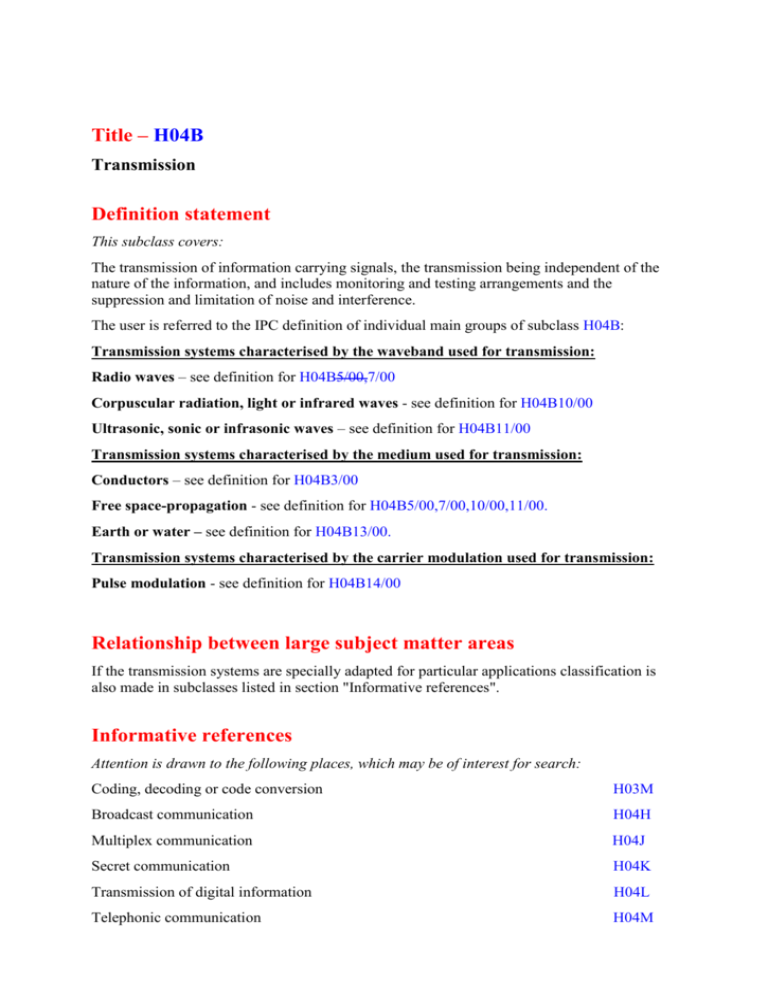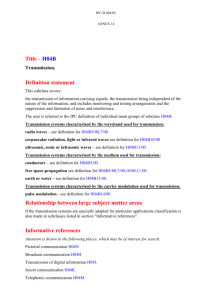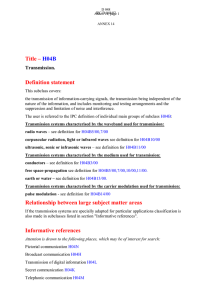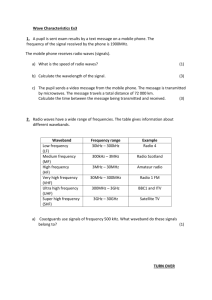Definition statement
advertisement

Title – H04B Transmission Definition statement This subclass covers: The transmission of information carrying signals, the transmission being independent of the nature of the information, and includes monitoring and testing arrangements and the suppression and limitation of noise and interference. The user is referred to the IPC definition of individual main groups of subclass H04B: Transmission systems characterised by the waveband used for transmission: Radio waves – see definition for H04B5/00,7/00 Corpuscular radiation, light or infrared waves - see definition for H04B10/00 Ultrasonic, sonic or infrasonic waves – see definition for H04B11/00 Transmission systems characterised by the medium used for transmission: Conductors – see definition for H04B3/00 Free space-propagation - see definition for H04B5/00,7/00,10/00,11/00. Earth or water – see definition for H04B13/00. Transmission systems characterised by the carrier modulation used for transmission: Pulse modulation - see definition for H04B14/00 Relationship between large subject matter areas If the transmission systems are specially adapted for particular applications classification is also made in subclasses listed in section "Informative references". Informative references Attention is drawn to the following places, which may be of interest for search: Coding, decoding or code conversion H03M Broadcast communication H04H Multiplex communication H04J Secret communication H04K Transmission of digital information H04L Telephonic communication H04M Pictorial communication H04N Paging systems using radio links (Selecting) H04Q Transmission systems for measured values, control or similar signals G08C Speech analysis or synthesis G10L Special rules of classification Transmission systems characterised by the medium used for transmission or by band of employing waves should be classified in groups 3/00,5/00,7/00,10/00,11/00 or in residual group 13/00. Transmission systems characterised by the use of carrier modulation or sub-carrier should be classified in group 14/00 and details thereof, in group 1/00. Title – H04B1/00 Details of transmission systems not covered by a single one of groups 3/00 to 13/00; Details of transmission systems not characterised by the medium used for transmission. Definition statement This group covers: Details of transmission systems that are general for transmission systems covered by two or more groups 3/00 to 13/00. Details of transmission systems not characterized by the medium used for transmission. References relevant to classification in this group This group does not cover: Details of transmission systems explicitly covered by one of groups 3/00 to 13/00 Demodulation or transference of modulation from one carrier to another H03D Informative references Attention is drawn to the following places, which may be of interest for search: Spatial arrangements of component circuits in radio pills for living beings A61B5/07 Waveguides; Resonators, lines or other devices of the waveguide type H01P Glossary In this group, the following terms or expressions are used with the meaning indicated: Homodyne receiver: a receiver in which an oscillating valve adjusted to, or locked with, an incoming carrier to enhance its magnitude and improve demodulation. Superheterodyne receiver: a receiver in which the frequency of the incoming signal is reduced in a mixer or frequency changer by heterodyning with another frequency at the local oscillator. (Heterodyning: combining two sinusoidal frequencies radio frequency waves in a non-linear device resulting in sum and difference frequencies). Synchrodyne receiver: a receiver in which a mixing carrier signal is inserted in exact synchronism with the original carrier at the transmitter. Used for the selective detection of signals coded in a certain way. Title – H04B3/00 Line transmission systems Definition statement This group covers: Transmission systems characterised by the medium being conductors, e.g. wires, metal cables, waveguides. References relevant to classification in this group This group does not cover: Alarm systems using power transmission lines G08B25/06 Near-field transmission systems, e.g. inductive loop type H04B5/00 Informative references Attention is drawn to the following places, which may be of interest for search: Communication cables or conductors H01B11/00 Waveguides; Resonators, lines or other devices of the waveguide type H01P Circuit arrangements for providing remote indication of network condition H02J13/00 Title – H04B5/00 Near-field transmission systems, e.g. inductive loop type Definition statement This group covers: Near-field transmission systems, e.g. inductive loop type. References relevant to classification in this group This group does not cover: Paging systems in general G08B Title – H04B7/00 Radio transmission systems, i.e. using radiation field Definition statement This group covers: Radio transmission systems, i.e. systems using radiation field. References relevant to classification in this group This group does not cover: Near-field transmission systems, e.g. inductive loop type H04B5/00 Suppression or limitation of noise or interference H04B15/00 Informative references Attention is drawn to the following places, which may be of interest for search: Diversity systems specially adapted for direction finding G01S3/72 Systems using reradiation of radio waves, e.g. secondary radar systems; Analogous systems G01S13/74 Aerials H01Q Selecting arrangements to which subscribers are connected via radio links H04Q7/00 Synonyms and Keywords In patent documents the following abbreviations are often used: CDMA - Code Division Multiple Access CDMA – TDMA – Hybrid Code- Time Division Multiple Access FDMA - Frequency Division Multiple Access FDMA - TDMA - Hybrid Frequency Time Division Multiple Access SDMA- Space Division Multiple Access SSMA - Spread-Spectrum Multiple Access TDMA - Time Division Multiple Access Title – H04B10/00 Transmission systems employing beams of corpuscular radiation, or electromagnetic waves other than radio waves, e.g. light, infra-red Definition statement This group covers: Transmission systems employing beams of corpuscular radiation, or electromagnetic waves other than radio waves, e.g. light, infra-red. Informative references Attention is drawn to the following places, which may be of interest for search: Optical elements, systems or apparatus G02B Devices or arrangements, the optical operation of which is modified by changing the optical properties of the medium of the devices or arrangements for control of the intensity, color, phase, polarization or directing of light, e.g. switching, gating, modulating or demodulating; Frequency changing Non-linear optics; Optical analogue/digital converters G02F Arrangements for handling beams of corpuscular radiation, e.g. focusing, moderating G21K1/00 Optical multiplex systems H04J14/00 Title – H04B11/00 Transmission systems employing ultrasonic, sonic or infrasonic waves Definition statement This group covers: Transmission systems employing ultrasonic, sonic or infrasonic waves. Informative references Attention is drawn to the following places, which may be of interest for search: Speech analysis or synthesis; Speech recognition G10L Telephonic communication H04M Loudspeakers, microphones or like acoustic electromechanical transducers H04R Stereophonic systems H04S Title – H04B13/00 Transmission systems characterised by the medium used for transmission, not provided for in groups 3/00 to 11/00. Definition statement This group covers: Transmission systems characterised by the medium used for transmission, not provided for in groups 3/00 to 11/00, e.g. when the medium is the earth, large mass of water thereon, pipe lines, interior ship sections or other massive objects. Title – H04B14/00 Transmission systems not characterised by the medium used for transmission Definition statement This group covers: Transmission systems characterised by the use of a carrier modulation. References relevant to classification in this group This group does not covers: Details of transmission systems not characterized by the medium used for transmission H04B1/00 Informative references Attention is drawn to the following places, which may be of interest for search: Demodulation or transference of modulation from one carrier to another H03D Coding, decoding or code conversion, in general H03M Title – H04B15/00 Suppression or limitation of noise or interference Definition statement This group covers: Suppression or limitation of noise or interference. References relevant to classification in this group This group does not covers: Suppression or limitation of noise or interference by means associated with receiver H04B1/10 Informative references Attention is drawn to the following places, which may be of interest for search: Structural association with measuring or protective devices or electric components with suppressor for radio interference H02K11/00 Screening of apparatus or components against electric or magnetic fields H05K9/00 Title – H04B17/00 Monitoring; Testing Definition statement This group covers: Methods and apparatus for determining the manner in which a transmission system is functioning or the existence, type and location of any trouble. References relevant to classification in this group This group does not covers: Monitoring, testing line transmission systems H04B3/46 Equipment for monitoring, testing transmission systems employing beams of corpuscular radiation, or electromagnetic waves other than radio waves H04B10/08 V. Nioukhovsky








